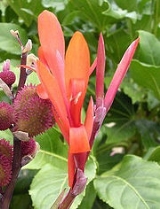
Canna 'Musaefolia'
Encyclopedia
Canna 'Musaefolia' cultivars belong to the Foliage Group of Cannas
. In the first work devoted to Canna, Le Canna - authored by M. Chaté in 1867 with the co-operation of Monsieur Théodore Année
, we were provided with the first written description and details of origin. The Musaefolia members of the Foliage Group consist of a specimen that was accepted as a native species of Peru by the experts of the time, and at least 7 hybrids and cultivars carrying that parentage. The original "species" was unique because it was without rhizomes, and required to be kept constantly growing. No such species is known to exist in this age, and leading authorities treat C. musaefolia as a synonym of C. paniculata.
in 1858, from the resemblance of its leaves to those of the Musa
or banana-tree. It reaches a height of more than 8 ft (2.4 m) and has green, downy stems, and very large, oval, green leaves. Flowers small, orange-yellow. It is a tender species without rhizomes, and requires to be kept constantly growing. Peru
."
Nowadays, Canna excelsa is accepted as a synonym of C. paniculata. However, all currently known Cannas have rhizomes or tubers.

 "Resembles C. 'Musaefolia', but the stems and leaves are thicker and of a deeper green."
"Resembles C. 'Musaefolia', but the stems and leaves are thicker and of a deeper green."
A tall Foliage Group cultivar; dark green foliage, very large, broadly oblong shaped, maroon margin, spreading habit; oval stems, coloured green; flowers are upright, self-coloured salmon-red, staminodes are small, edges regular, style is red, petals purple with farina, fully self-cleaning; fertile both ways, not true to type, self-pollinating, capsules round; rhizomes are thick, up to 3 cm in diameter, coloured purple; tillering is prolific. Introduced by Théodore Année, Passy
, France, EU in 1860.
As all Canna grown today have rhizomes or tubers, this hybrid must now be considered to be extinct.
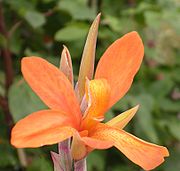
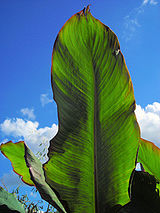 "Stems green and downy, 5 ft. to 6½ ft. high. Leaves very large, wide, green. Flowers small, orange. Rootstocks very small. Introduced by E. Chaté et fils, sentier Saint-Antoine, Saint-Mandé, Paris, France, EU. in 1862."
"Stems green and downy, 5 ft. to 6½ ft. high. Leaves very large, wide, green. Flowers small, orange. Rootstocks very small. Introduced by E. Chaté et fils, sentier Saint-Antoine, Saint-Mandé, Paris, France, EU. in 1862."
A tall Foliage Group cultivar; green foliage, very large, broadly oblong shaped, maroon margin, spreading habit; oval stems, coloured green; spikes of flowers are open, red-orange with orange-red spots, staminodes are medium size, edges regular, labellum is gold flecked, stamen is gold with orange markings, style is orange, petals yellow, fully self-cleaning; fertile both ways, not true to type, self-pollinating, capsules round; rhizomes are thick, up to 3 cm in diameter, coloured pink and purple; tillering is prolific.
This does not normally flower in northern climates, but if kept growing over the winter in a heated greenhouse or conservatory it will happily bloom either in late spring or late summer.
The description above states that it is without rhizomes. No such Canna rhizome challenged cultivar currently exists and therefore this must be considered extinct.
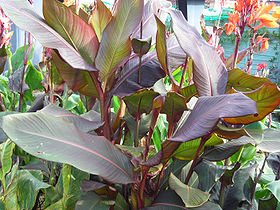 "Stems dark red, 6½ ft. high. Leaves dark purple-red, oval, very large. Flowers small, salmon-red. Rootstocks very tender, with fibrous roots. Introduced by Théodore Année, Passy, France, EU in 1862."
"Stems dark red, 6½ ft. high. Leaves dark purple-red, oval, very large. Flowers small, salmon-red. Rootstocks very tender, with fibrous roots. Introduced by Théodore Année, Passy, France, EU in 1862."
A tall Foliage Group cultivar; dark green foliage, very large, broadly oblong shaped, maroon margin, spreading habit; oval stems, coloured green; flowers are upright, self-coloured salmon-red, staminodes are small, edges regular, style is red, petals purple with farina, fully self-cleaning; fertile both ways, not true to type, self-pollinating, capsules round; rhizomes are thick, up to 3 cm in diameter, coloured purple; tillering is prolific.
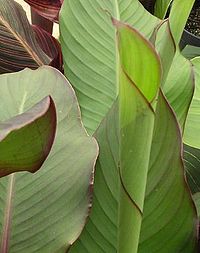 The original five musaefolia hybrids have been recently joined by this cultivar, which may be a synonym of one of the five above, or a new hybrid. It is regarded by many enthusiasts as a magnificent specimen and is becoming increasingly popular.
The original five musaefolia hybrids have been recently joined by this cultivar, which may be a synonym of one of the five above, or a new hybrid. It is regarded by many enthusiasts as a magnificent specimen and is becoming increasingly popular.
A giant Foliage Group cultivar; green and purple variegated foliage, large, oval shaped, maroon margin, branching habit; half-round stems, coloured green + purple; spikes of flowers are upright, self-coloured orange-red, staminodes are long and narrow, fully self-cleaning; fertile both ways, not true to type, self-pollinating, capsules globose; rhizomes are thick, up to 7 cm in diameter, coloured purple; tillering is prolific. Introduced by Herb Kelly, USA, from Venezuela.
The earliest reference to this is the catalogue of Kelly's Plant World, California, USA. 1989.
Canna (plant)
Canna is a genus of nineteen species of flowering plants. The closest living relations to cannas are the other plant families of the order Zingiberales, that is the gingers, bananas, marantas, heliconias, strelitzias, etc.Canna is the only genus in the family Cannaceae...
. In the first work devoted to Canna, Le Canna - authored by M. Chaté in 1867 with the co-operation of Monsieur Théodore Année
Théodore Année
Théodore Année, a wealthy, retired French diplomatic consul in South America, returned to France in the mid 1840's and settled in rue des Réservoirs, Passy, Paris, where he devoted himself to the culture of tropical plants from South America, having brought back with him the taste for plants with...
, we were provided with the first written description and details of origin. The Musaefolia members of the Foliage Group consist of a specimen that was accepted as a native species of Peru by the experts of the time, and at least 7 hybrids and cultivars carrying that parentage. The original "species" was unique because it was without rhizomes, and required to be kept constantly growing. No such species is known to exist in this age, and leading authorities treat C. musaefolia as a synonym of C. paniculata.
Origin
Monsieur Chaté writes, "This species was formerly described in the English, Dutch, and German horticultural journals under the name of C. excelsa. It was named musæfolia by Monsieur Théodore Année, who introduced it into FranceFrance
The French Republic , The French Republic , The French Republic , (commonly known as France , is a unitary semi-presidential republic in Western Europe with several overseas territories and islands located on other continents and in the Indian, Pacific, and Atlantic oceans. Metropolitan France...
in 1858, from the resemblance of its leaves to those of the Musa
Muša
Mūša is a river in Northern Lithuania and Southern Latvia , having its confluence with river Nemunėlis , in Latvia, near city Bauska. Mūša is a tributary of the river Lielupė. Mūša is 164 kilometres long....
or banana-tree. It reaches a height of more than 8 ft (2.4 m) and has green, downy stems, and very large, oval, green leaves. Flowers small, orange-yellow. It is a tender species without rhizomes, and requires to be kept constantly growing. Peru
Peru
Peru , officially the Republic of Peru , is a country in western South America. It is bordered on the north by Ecuador and Colombia, on the east by Brazil, on the southeast by Bolivia, on the south by Chile, and on the west by the Pacific Ocean....
."
Nowadays, Canna excelsa is accepted as a synonym of C. paniculata. However, all currently known Cannas have rhizomes or tubers.
Hybrids
We do know that the early hybridizers, led by Monsieur Année, crossed the original import and produced cultivars, some of which still live on.Canna 'Musaefolia Hybrida'


A tall Foliage Group cultivar; dark green foliage, very large, broadly oblong shaped, maroon margin, spreading habit; oval stems, coloured green; flowers are upright, self-coloured salmon-red, staminodes are small, edges regular, style is red, petals purple with farina, fully self-cleaning; fertile both ways, not true to type, self-pollinating, capsules round; rhizomes are thick, up to 3 cm in diameter, coloured purple; tillering is prolific. Introduced by Théodore Année, Passy
Passy
Passy is an area of Paris, France, located in the XVIe arrondissement, on the Right Bank. It is traditionally home to many of the city's wealthiest residents.Passy was formerly a commune...
, France, EU in 1860.
Canna 'Musaefolia Minima'
"Leaves of a whitish green, badly set. Flowers small, orange brown. No rootstocks. Introduced by Théodore Année, Passy, France, EU in 1860."As all Canna grown today have rhizomes or tubers, this hybrid must now be considered to be extinct.
Canna 'Musaefolia Peruviana'


A tall Foliage Group cultivar; green foliage, very large, broadly oblong shaped, maroon margin, spreading habit; oval stems, coloured green; spikes of flowers are open, red-orange with orange-red spots, staminodes are medium size, edges regular, labellum is gold flecked, stamen is gold with orange markings, style is orange, petals yellow, fully self-cleaning; fertile both ways, not true to type, self-pollinating, capsules round; rhizomes are thick, up to 3 cm in diameter, coloured pink and purple; tillering is prolific.
This does not normally flower in northern climates, but if kept growing over the winter in a heated greenhouse or conservatory it will happily bloom either in late spring or late summer.
Canna 'Musaefolia Perfecta'
"Stems from 5 ft. to 6½ ft. high. Leaves broad, very firm, of a handsomish whiteish green. Flowers small, yellow. Roots fiberous, without rootstocks. Introduced by Théodore Année, Passy, France, EU in 1862."The description above states that it is without rhizomes. No such Canna rhizome challenged cultivar currently exists and therefore this must be considered extinct.
Canna 'Musaefolia Rubra'

A tall Foliage Group cultivar; dark green foliage, very large, broadly oblong shaped, maroon margin, spreading habit; oval stems, coloured green; flowers are upright, self-coloured salmon-red, staminodes are small, edges regular, style is red, petals purple with farina, fully self-cleaning; fertile both ways, not true to type, self-pollinating, capsules round; rhizomes are thick, up to 3 cm in diameter, coloured purple; tillering is prolific.
Canna 'Musaefolia Grande'

A giant Foliage Group cultivar; green and purple variegated foliage, large, oval shaped, maroon margin, branching habit; half-round stems, coloured green + purple; spikes of flowers are upright, self-coloured orange-red, staminodes are long and narrow, fully self-cleaning; fertile both ways, not true to type, self-pollinating, capsules globose; rhizomes are thick, up to 7 cm in diameter, coloured purple; tillering is prolific. Introduced by Herb Kelly, USA, from Venezuela.
The earliest reference to this is the catalogue of Kelly's Plant World, California, USA. 1989.
External links
- Claines Canna Collection
- Canna News: Musaefolia complex unravelled
- Canna News: Musaefolia Peruviana, genetic volcano!
- Canna News: Wot, no rhizomes?
See also
- CannaCanna (plant)Canna is a genus of nineteen species of flowering plants. The closest living relations to cannas are the other plant families of the order Zingiberales, that is the gingers, bananas, marantas, heliconias, strelitzias, etc.Canna is the only genus in the family Cannaceae...
- List of Canna species
- List of Canna cultivarsCanna (Plant) GalleryThis is a gallery of named canna cultivars, representative of the various Canna cultivar groups. Names of cultivars are regulated by the International Code of Nomenclature for Cultivated Plants, are registered with an International Cultivar Registration Authority and conform to the rules of the...
- List of Canna hybridists

